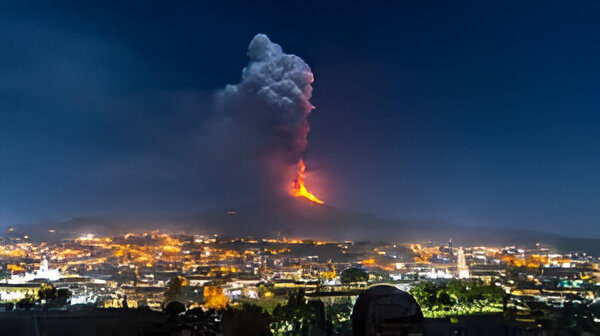Mount Etna eruption on Monday morning reminded everyone why this fiery giant is Europe’s most active volcano. At around 11:24 a.m., the volcano sent a massive column of ash, gas, and volcanic rock soaring into the sky, drawing attention not just in Italy but worldwide.
If you’ve ever stood near Mount Etna, you know it feels alive — but when a Mount Etna eruption happens, the mountain roars like it’s telling a story centuries in the making.

What Actually Happened?
According to Italy’s National Institute of Geophysics and Volcanology (INGV), the eruption started with a pyroclastic flow — a fast-moving and dangerously hot cloud of ash and gas that raced down the side of the Southeast Crater. Scientists believe this was triggered by a partial collapse inside the crater itself.
Not long after, the eruption shifted into a full-on lava fountain, with fiery red bursts spraying high into the air. The whole thing was both terrifying and beautiful — a reminder of how unpredictable nature can be.
By early afternoon, though, the volcanic drama began to settle. The ash cloud, which had reached over 6.5 kilometers (around 4 miles) high, started to fade. INGV downgraded its aviation alert from red to yellow, and flights at nearby Catania Airport continued mostly uninterrupted.

Was Anyone in Danger?
Fortunately, no. Sicily’s regional president, Renato Schifani, said experts assured him there was no risk to nearby residents or tourists. The lava flow didn’t cross into any populated areas and stayed within the Valley of the Lion, a well-known (and now temporarily off-limits) area often explored by hikers.
Still, local civil protection authorities are urging people to avoid the mountain for now. Even though the eruption is over, Mount Etna is not something to take lightly — even when it’s calm, it can shift without warning.
Etna’s Not New to This
This eruption didn’t come out of nowhere. Mount Etna has been restless for weeks, and scientists say we’re likely in the middle of one of its active phases.
Volcanologist Marco Viccaro explained it best: Etna is in a “recharge phase,” which basically means magma is moving closer to the surface. It’s a natural process for an active volcano, but one that usually brings bursts of activity — like the one we saw Monday.
And while this event was impressive, Viccaro says it’s not as intense as the eruptions Etna produced between 2020 and 2022. He also noted this kind of activity — called strombolian eruptions — tends to build up slowly, then explode in short, powerful episodes.
Translation? This could be just the beginning of a busy summer for Etna.
Life in the Shadow of a Volcano
For locals in Sicily, living near Mount Etna is part of everyday life. It’s both a beautiful landmark and a force of nature you learn to respect. When it erupts, people don’t panic — they pay attention, they follow expert guidance, and they carry on.
That’s exactly what happened Monday.
Tourists in the area were quickly moved out of danger zones. Flights kept moving. Authorities responded swiftly. And while videos of the eruption made headlines around the world, on the ground, it was a well-handled event.
Final Thoughts
Monday’s eruption was powerful, yes — but not a crisis. It was a reminder that Etna is alive, still shaping the landscape of Sicily as it has for thousands of years.
Whether you’re watching from afar or planning a trip to the region, remember: volcanoes like Etna demand our awe, but also our caution. They’re stunning forces of nature — and they don’t run on a schedule.
